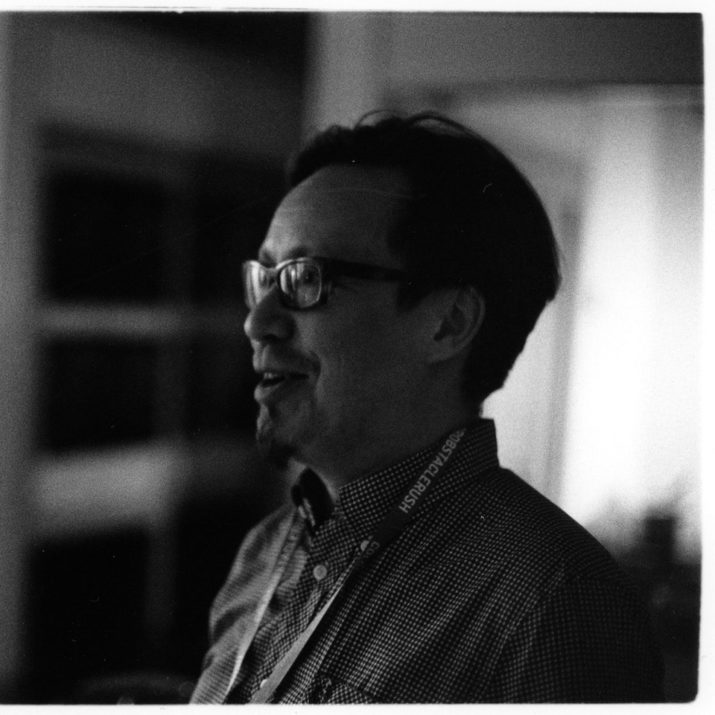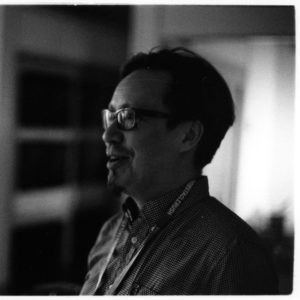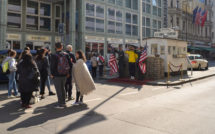

This is part of our special feature, Contemporary Urban Research in the European City.
In 2013, a network of urban researchers with various national and disciplinary background was founded in Berlin. This small community of committed scholars working in different fields of urban studies, had been linked by the approach of creating an interdisciplinary and transnational discursive space for a free exchange on art, public spaces, and urban activism. Involving academics, artists, activists and students, it created a growing platform. Through a comparative focus on cities such as Helsinki, Berlin, Istanbul, Paris, Tallinn, Budapest, and St. Petersburg, it generates an innovative dialogue between post-socialist, global or globalizing cities. The anthropologist Pekka Tuominen (University of Helsinki) joined TACT in 2017.
—Eszter Gantner for EuropeNow
EuropeNow Could you tell us a little about yourself?
Pekka Tuominen I’m a social and cultural anthropologist based at the university of Helsinki. We are collaborating with various universities that are linked with the TACT network. I’ve worked for 15 years doing research on urban transformation in Istanbul, but am now involved with a new project that was initiated at the beginning of 2017, which concentrates on a district of Helsinki called Kontula, which is 16 kilometers to the east from the city center. It is a suburban estate built mostly in the 1960s and 1970s, and has a really strong reputation as a dangerous place. However, reality and its reputation differ widely. I have been doing field work there for the whole year and now I’m writing a book about what’s happening there.
EuropeNow Our activities really try to mirror this kind of interdisciplinary approach that we are representing with TACT. Since you are working now on Kontula in Helsinki, I would like to ask you from the perspectives of urban anthropology, and as someone who is working with an urban neighborhood, what you considered the main challenges in European cities, particularly in Helsinki?
Pekka Tuominen I think, that there are two likely interrelated discourses and it is really very important to acknowledge both. If we start from the academic level of research, there are some trends in urban studies that have dominated the discussion for a long time: these are the umbrella terms such as gentrification, segregation, or modernization. And I think, that the everyday level of conducting ethnographic fieldwork, to work in the actual field for a long time, is a good way to criticize and to question the applicability of these terms, to avoid the creation of monolithic ideas, because they influence the research too much. That is also one of the other reasons why it is good to have people from different fields, such as history or arts, or design and architecture, as we do in our collaborations.
We can question these narratives that have become sort of universalized. The themes are of course important, but there is quite a lot of variety in different contexts, depending on the history of the area, on the demographics of the area, and on its most recent changes. They are also quite distinct in different European countries. If you just do simple questionnaires with policy makers and inhabitants, you will get what you have expected, because the same questions are in the media and have started to dominate many discussions of urbanity, often in very different contexts. The inhabitants are well aware of the “correct” answers. But then, by spending a longer time in one place and participating in people’s everyday life, you start to realize that it is much more complex. Everyday life is also paradoxical. At first, people might say answers that are expected of them, not just by researchers but also by their peers and their friends. But then again, when you spend more time with them, you realize, that it is not really that simple. People constantly refer to the reputation of the district, and they would say that it needs to be cleaned up, that it is dangerous and full of social problems. But, at the same time, there are a lot of other values associated with the area: The sense of community, the idea of home, that it represents to the inhabitants. Many people who are living in Kontula say that they feel perfectly safe there, but they wouldn’t feel safe in the center. There are significant boundaries in the cityscape and the stereotypical representations are just one side of the story.
EuropeNow So, if I understand you correctly, you would also suggest questioning these ruling metanarratives in urban studies? Like the gentrification, which is a very good example, because the gentrification is now a quite wide-spread term. But exactly this micro-level research that you are doing as an anthropologist is what shows that the reality of urban living and urban existence is much more complicated and complex, as these master narratives would suggest. If I take the case of gentrification, for example in Berlin, or in London, or in Paris, then you are faced with big issues, such as that poor people are living now in the outskirts of the cities, pushed out by the middle class; there is also the homogenization of urban life, heavily influenced by a certain model of middle-class living. But, at the same time, if you go to certain neighborhoods, there are also advantages that this kind of transformation brings with it. I remember the Latte example from Kontula. Could you tell us about it because it is so symbolic and clearly illustrates this paradox that we are faced with both in the field of urban research as well as in urban life: On the one hand, master narratives and models, and, on the other hand, the micro-level realities of the everyday life.
Pekka Tuominen Yes, that it is a very good example, because these terms have become so influential. Gentrification is definitely a useful concept, but we need to acknowledge its limits. It informs us of significant processes happening globally, and it really helps us to put all these processes into a comparative framework. Without theoretical concepts we would have just isolated descriptions of different places. I’m not saying that the terms are not useful, but they do not capture significant specificities. One of the examples from my field site concerns this cafe that opened a year and a half ago—the first one that serves lattes in a cozy environment. For many, lattes have become the symbol of gentrification and the middle class’s invasion of a place. But the locals adopted this cafe immediately. You can also get regular coffee there for a very cheap price. Lattes are cheap there as well. There are lots of mothers with children and lots of elderly people, not your usual hipsters, who are taking over the suburban estate. It was a welcome alternative because this kind of places didn’t exist in the area before which, formerly, had pubs, some of them quite grim. In essence, there really was no place to go with your children. Lattes have become almost a universal symbol of this gentrification but when you start examining what’s happening, it is much more complex. These imaginations are interesting because they can lead to the development of the area into quite different directions. The same applies to music and to art festivals in the area that we are organizing. We try to acknowledge these processes of urban transformation and deal with them. This is a form of intervention research—we are doing the project together with the inhabitants, but also studying academically what the responses and the possible problems related to these new forms of urban culture in the area are.
EuropeNow The festival you are organizing now—would you understand it as a kind of bottom-up process, as a form of participation? Was this initiated by the inhabitants, or was it initiated by a network of artists? Is it an intervention, a social intervention? And how would you describe this? This is again one of the powerful issues that we are discussing in the European cities, and, of course, our histories and our everyday lives are different. However, we share a lot of praised values, such as participation of the citizens, who can shape and recreate the city together with the authorities, with the municipalities and with other urban agents. Would you see this in the case of this electronic festival too? Do you see it, as a part of this movement? And was it initiated by the local urban citizens?
Pekka Tuominen I think that, first of all, participation is probably just another big buzz word, especially in urban policy initiatives in Helsinki, but then again, it is important to study carefully what participation means and involves. Unfortunately, it often means that policy makers welcome some ideas, but then make the final decisions themselves. Another way would be to include participatory approaches from the beginning of an initiative and to concentrate on the actual democratic processes and the questions of power involved. In our case, the idea of the festival, Kontula Electronic, came from one cultural producer and one artist, who both are living in the area. We formed one small working group around the initiative with other producers, artists, researchers. However, what we really wanted to build up was a framework through real participation and true experience of successful participation. Such an initiative takes time. People have to feel welcomed and listened to question the decision-making mechanism. And I think it is never possible to be 100 percent correct democratic in this. But we try to work with consensus, we try to avoid voting about different solutions because that would always divide people who are involved. Overall, we are quite successful and also try to be open towards different actors and different initiatives in the local community. We had, for example, a local scout organization, participating in the electronic music festival, which is perhaps quite untypical. And we try to reach many people, including children and youths. And, at the same, my research focuses on how these processes work on the everyday level. How should the meetings work in the best possible way, what are the other ways to get everyone’s voice heard and how to actually do these things and not just plan them.
We will be very busy making our final decisions. But, at the same time, I see the festival as a kind of urban laboratory with high artistic quality, not just as a neighborhood festival of local actors. Of course, local actors are important as well, but you have to combine this artistic quality with true participation—points that really define many aspects of the future of urban spaces in Helsinki. Especially if great ideas are supposed to go beyond the planning stage to become an annual event with sub-events throughout the year, not just the hipsters from the center taking over the area for one weekend, and then leaving it to the inhabitants to clean up the garbage afterwards.
EuropeNow The Berlin example also illustrates what you just referred to in that you have examples for “good” kinds of participation, when the broadest scope of interests are considered and balanced as the case of the Tempelhofer Feld, show. And you find the “bad” kinds of participation too, like the Berliner Schloß-Project (incl. Humboldt-Forum) which was initiated by a small group of citizens; however, their idea of reconstructing the Schloß had been rejected by various urban developers, scholars and urban citizens. There was no negotiation between the various interests and no balancing of the differences. Thus, negotiations seem to be one of the key moments in these whole processes.
But who is conducting urban research for example in Finland? Apart from the University of Helsinki, is there are any other institution in Finland working on interdisciplinary urban issues and what does such an approach look like?
Pekka Tuominen We need historians, sociologists, anthropologists, architects, designers to tackle these questions. And because of the disciplinary structure of the universities and of other institutes it is good to have alternatives. People can be located in the different places, but they still communicate by using different channels. The national and international frameworks come together in very interesting ways. In Finland many of the university departments are tiny, such as anthropology in Helsinki, for instance. We can share many theoretical and methodological approaches but study very different issues in wildly different contexts. If I am dealing with specifically urban issues, different people are involved. We have created quite some good initiatives and people share their insights and their data. It is working well but, at the same time, it is just the beginning. It is also essential that professionals outside of academia are tackling these questions in informal settings and beyond academic conferences Conferences are important, but through my work with TACT, it is interesting that different cities and questions of equal nature require quite different methodologies. Perhaps this takes us back to the beginning of our discussion. I’m not a big fan of having just a few institutions dedicated to urban studies, which then define themes, methodological approaches and popular concepts. This takes us back to the widespread umbrella terms such as gentrification and segregation that we started with. It requires a lot of work to uphold all the informal networks to be in touch with people, to follow up on what is happening in the various fields. But I think that we are heading in the right direction.
Pekka Tuominen holds a PhD in Social and Cultural Anthropology. He is currently a Post-Doctoral researcher at the University of Helsinki. His research deals with the sociocultural dimensions of urban transformation in Istanbul and he has recently initiated a multidisciplinary research project in the stigmatised Kontula district of Helsinki, studying the urban transformation of the area and examining new possibilities of participatory urban culture connecting its neighbourhoods.
Eszter Gantner holds a Ph.D. in History from the Humboldt University of Berlin. She has studied Law, History and Political Sciences in Budapest, Jerusalem, and Berlin. Gantner has been a visiting scholar at the Harriman Institute, Columbia University, in 2015 and 2016. Currently she is academic employee at the Herder-Institute for Historical Research on East Central Europe, where she completed a book project, Knowledge Transfer and Urbanization in East Central Europe 1873-1914. Simultaneously, she leads with Oleg Pachenkov the TACT-Project “Claiming the public space” funded by the Alexander von Humboldt Foundation and located at the Georg Simmel Center for Metropolitan Research-Humboldt University of Berlin. Her research fields include: history of science and knowledge, urban history (with focus on East Central Europe), intellectual history of Europe, material culture history, digital humanities in East Central Europe, and Jewish history of East Central Europe.
Published on May 1, 2018.




